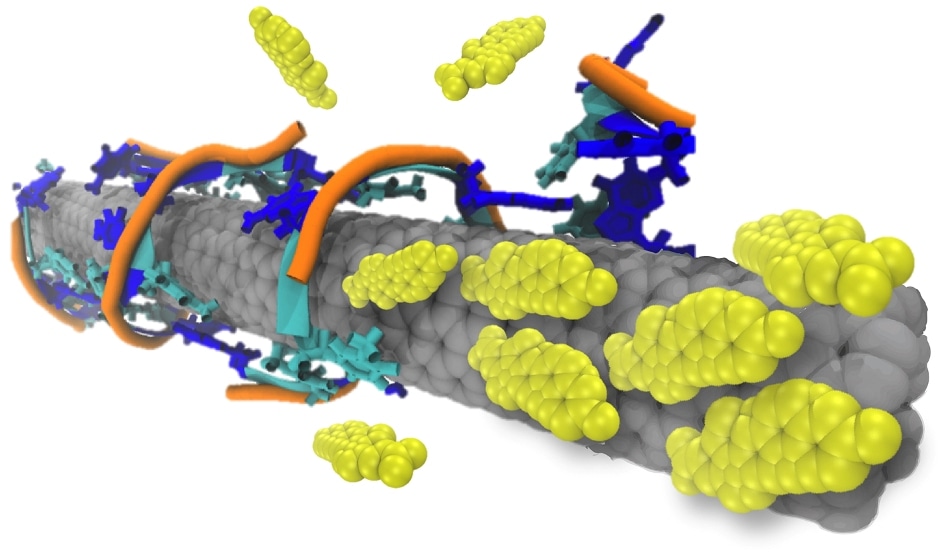Jul 18 2019
Imagine the amount of data that can be collected through a sensor that is sufficiently small to interact with and penetrate individual cells.
 This is a carbon nanotube sensor for lipids inside of cells. The lipids are the yellow molecules binding to the surface. (Image credit: Daniel Roxbury)
This is a carbon nanotube sensor for lipids inside of cells. The lipids are the yellow molecules binding to the surface. (Image credit: Daniel Roxbury)
Daniel Roxbury, chemical engineering assistant professor at the University of Rhode Island (URI), is planning to utilize carbon nanotubes—whose width is 100,000 times smaller than that of a single strand of human hair—to act as sensors and collect data for biomedical purposes.
For the study, the National Science Foundation (NSF) awarded Roxbury a five-year grant of $500,000 to develop a whole new method for imaging inside the live cells. Roxbury received the funding through the Faculty Early Career Development Program (CAREER) of NSF. “Spectral imaging for sub-cellular nanometrology and nanotoxicology” is the title of the project.
Carbon nanotubes have extraordinary physical and optical properties, which have demonstrated applications in materials science, chemistry, and biology. The nanotubes emanate light. They can function as sensors by changing the color of the light that is emitted in response to a detected molecule. We will use this technique to count the number of nanotube sensors that enter the cells.
Daniel Roxbury, Assistant Professor, Chemical Engineering, The University of Rhode Island
As soon as the carbon nanotubes penetrate the live cells, Roxbury will examine how the cells interact with the nanotubes.
“We are interested in how the cells process the internalized nanotubes and what the ultimate fate is of the nanotubes,” stated Roxbury. “Do the nanotubes eventually get released from the cells? The answer to that question remains largely unknown.”
Roxbury conceded that potential risks will always be there whenever a foreign material is introduced.
“There are inherent risks associated with potential toxicity,” added Roxbury. “We have gone through several processing and purification steps to increase the biocompatibility of our nanotubes. In doing so, we have observed negligible side effects at the low concentrations of nanotubes that are required for sensing applications.”
Roxbury will perform the study in his NanoBio Engineering Laboratory, where he will be helped by three undergraduates and two graduate students.
A hyperspectral fluorescence microscope is the piece of equipment that would be used most often. This instrument was bought for $250,000 when Roxbury joined the URI faculty in the year 2016 and established his laboratory.
Initially, the team will study the behavior of carbon nanotubes in biological fluids (blood plasma) and simple solutions and then move on to live cells. After the researchers are ready to investigate the interactions between carbon nanotubes and a wide range of live human cells, they will perform a series of experiments using cells lining the blood vessels, cancer cells, and immune cells.
Roxbury is the only principal investigator on the project, but he anticipates collaborating with Angela Slitt, a professor in the College of Pharmacy at URI.
I’m looking forward to working with Dan because it’s an excellent opportunity to apply innovative, new technologies to advance biomedical sciences. I’m specifically interested in discovering non-invasive methods to detect fatty liver disease.
Angela Slitt, Professor, College of Pharmacy, The University of Rhode Island
“We are developing these nanotube-based sensors for a variety of diseases,” Roxbury said. “In addition to the detection of non-alcoholic fatty liver disease, a precursor to hepatitis, we are also creating sensors for the early detection of cancers for use in implantable and/or wearable devices.”
The grant stipulates that the study should be integrated into a kindergarten to 12th grade educational and outreach program via practical laboratory experience and interactive seminars.
“We’ve established an outreach program at Narragansett High School for juniors and seniors who are interested in pursuing STEM-related careers,” added Roxbury. “An eight-week program in the spring will enable students to attend interactive seminars and visit my lab for hands-on experience in nanotechnology and biology.”
Additionally, information from Roxbury’s study project will be incorporated into a bionanotechnology course that he provides every other fall semester for graduate students and upperclassmen. The course includes guest lectures from renowned figures in academia and local biotech startup companies.
Roxbury hoping to create file provisional patents and intellectual property owing to discoveries from the latest imaging method.
This fundamental work will aid in the development of nanotubes as robust and commercially available sensors for routine biomedical usage.
Daniel Roxbury, Assistant Professor, Chemical Engineering, The University of Rhode Island